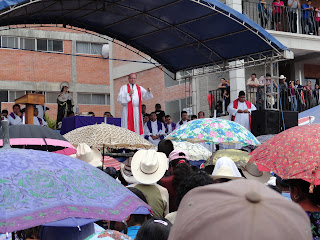The Stations of the Cross is a Catholic devotion from the late middle ages that has perdured for many years and expresses the desire of people of faith to walk with the Lord on His way to the Cross.
This year more than 3,000 came to Santa Rosa de Copán for the diocesan Stations of the Cross. Some traveled eight hours in bus from southern Intibucá.
The Stations began at the Cathedral and ended in the parking lot of the Catholic University of Honduras campus.
As usual the stations were related to the reality of Honduras. Some of them were very thoughtful and I will try to translate some of the reflections later this weekend.
These are the themes this year:
- Jesus is sentenced to death: Corruption and Impunity
- Jesus takes up his cross: The marginalized and excluded in society
- Jesus falls the first time: Alcoholism and drug addiction
- Jesus meets his mother: Migration and disintegration of the family
- Simon of Cyrene is forced to carry the Cross: Environment
- Veronica wipes the face of Jesus: Builders of a new society
- Jesus falls the second time: Drug trafficking and hired assassins
- Jesus consoles the daughters of Jerusalem: Media of communication
- Jesus falls the third time: Repression and violence against women
- Jesus is stripped of his garments: Human rights and privatization
- Jesus is nailed to the cross: Politics and participative democracy
- Jesus dies on the cross: Abortion
- Jesus is taken down from the Cross: Martyrs for the faith and commitment for the people.
- Jesus is laid in the tomb: A frightened and silenced people
The sun was hot but people endured the three hours of the stations and a half hour sermon by the bishop at the end of the stations. To my surprise – and the surprise of a number of people – there was no Mass at the end.
 |
| Bishop Andino preaching at the end of the Stations |
But during the Stations people approached the priests for confessions. I too took advantage of the occasion to go to confession.
 |
| Confession in the streets |
These Stations are, for me, a marvelous manifestation of the faith of the people of the diocese. From remote villages they came, villages where they meet weekly in base communities.
They are a materially poor people but they have a faith that puts much of the world to shame.
 |
| Kneeling in the streets |
I am grateful to be here and have been able to walk with them on the Way of the Cross, which many of them live every day, sharing in the sufferings of Christ in their villages.
Some more photos follow.
 |
| Venerating the Cross after the Stations were over. |
 |
| Monseñor Darwin Andino, walking in the procession |
 |
| A banner, showing the presence of base communities |






1 comment:
What strikes me is how many of the stations of the cross all of humanity visits.
* At birth, we are also sentenced to death
* Some of us accept the burdens laid upon us by life
* Many of us experience times of loss of pride and self-sufficiency, as in falling publicly
* When that happens, many of us are unable to bear the weight of life alone and rely on doctors, nurses, medical people ... pastoral counselors
* Many of us suffer agonizing pain at some time in our lives.
* We all die
What I see in the Stations of the Cross is not so much how terribly Jesus suffered, though terrible it was, but how He experienced what humanity experiences. When we celebrate the Stations, we acknowledge how helpless we are to avoid pain, suffering, and death. When we join the body of Christ, we acknowledge that we are a cell in His suffering body, that we are joined in suffering.
A line in the epistles that struck me greatly is that in Hebrews 2:10, we are told that "By suffering, Christ was made perfect"
This is a remarkable statement. It says that Jesus was not perfect, that during His earthly sojourn, He lacked an essential quality of perfection. Through our suffering, at least when we do not bring it on ourselves, we approach Him.
Post a Comment